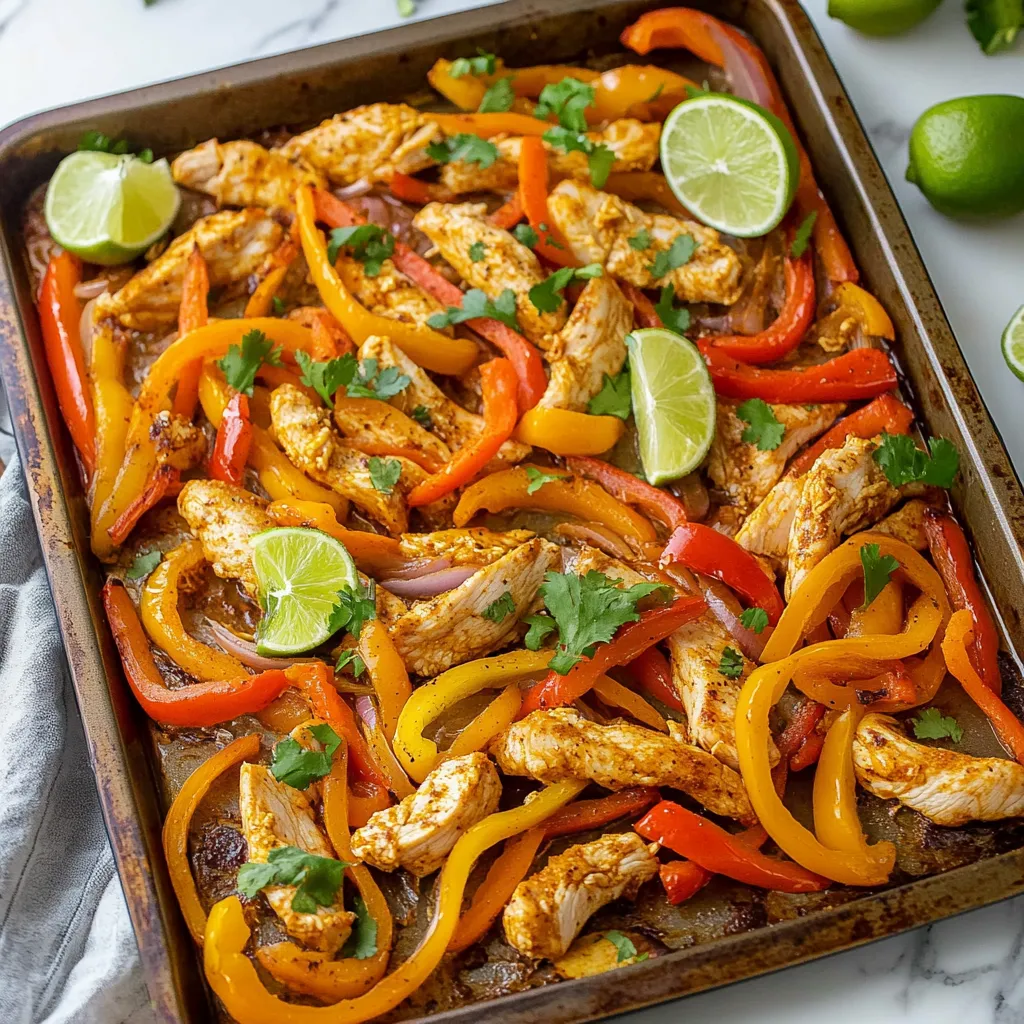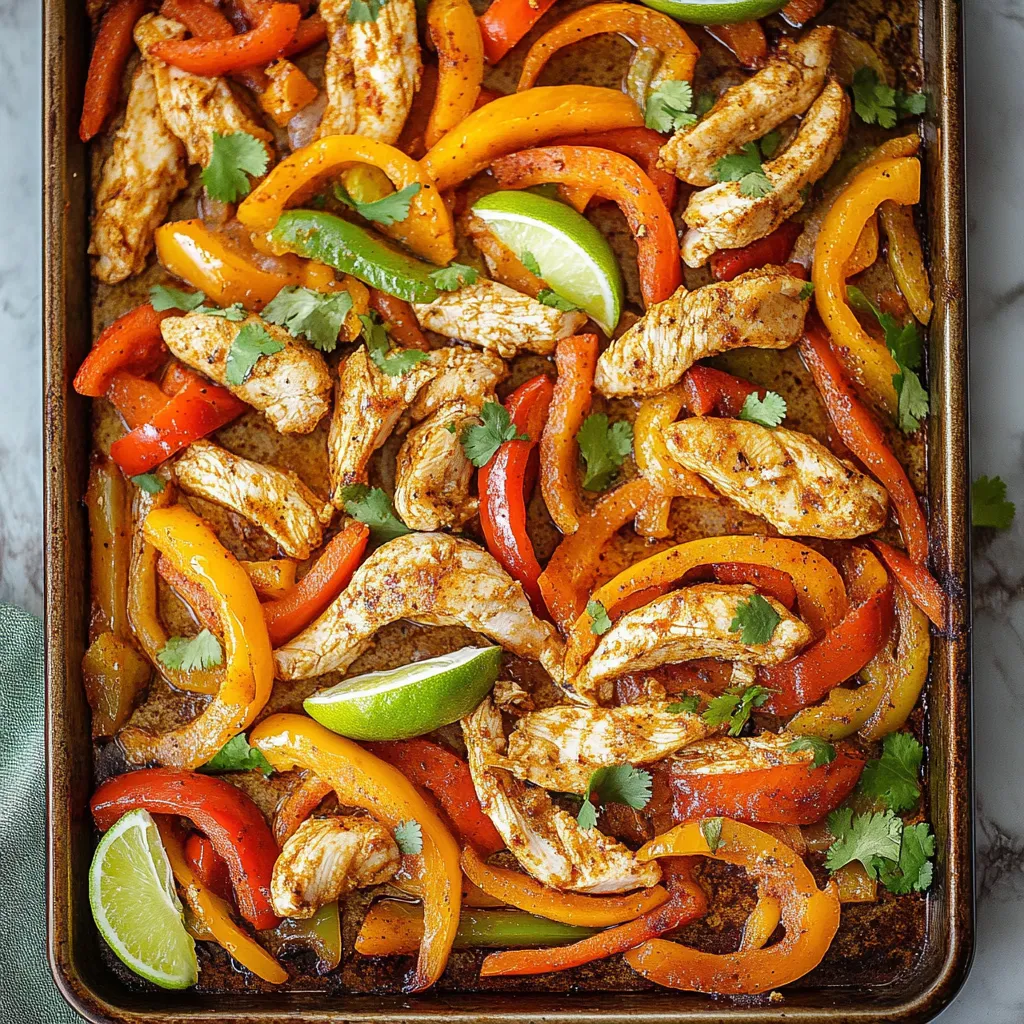 Pin it
Pin it
When you need dinner on the table fast but still want something that tastes like you put real effort into it, these sheet pan chicken fajitas are your answer. Everything goes onto one pan - the chicken, peppers, onions, and homemade spice blend - then the oven does all the work while you set the table or help with homework. The best part is that final broil step that gives you those slightly charred edges that make restaurant fajitas so irresistible.
I discovered this method during one of those weeks when everyone seemed to be coming and going at different times, and I needed something that could stay warm and still taste great. Now it's become our go-to family dinner because even my pickiest eater will load up a tortilla with these perfectly seasoned chicken and vegetables.
Essential Ingredients That Make the Difference
- Boneless chicken breasts: Cut them into half-inch strips so they cook evenly with the vegetables and stay tender rather than drying out
- Colorful bell peppers: Use a mix of red, yellow, and green for the prettiest presentation and slightly different flavors from each color
- Yellow onion: Slice it into strips rather than chunks so it caramelizes beautifully and doesn't overpower the other flavors
- Homemade fajita seasoning blend: Combining chili powder, cumin, paprika, garlic powder, and onion powder gives you way more flavor than those little packets
- Quality tortillas: Whether you choose flour or corn, warm them up in the oven during the last few minutes for that authentic touch
- Fresh lime and cilantro: These bright finishing touches really make the whole dish come alive
Step-by-Step Cooking Instructions
- Prepare your seasoning blend and preheat:
- In a small bowl, whisk together 1 tablespoon chili powder, 2 teaspoons ground cumin, 1 teaspoon paprika, 1 teaspoon garlic powder, 1 teaspoon onion powder, 1 teaspoon salt, and half a teaspoon black pepper. Preheat your oven to 425 degrees and line a large rimmed baking sheet with parchment paper for easy cleanup.
- Cut everything into uniform pieces:
- Slice your chicken breasts into strips about half an inch thick and 3-4 inches long - this ensures they'll cook at the same rate as your vegetables. Cut your bell peppers into strips of similar size, removing all the seeds and white parts. Slice your onion from pole to pole into strips about the same thickness as your peppers and chicken.
- Season and let it marinate:
- Place the chicken strips, pepper strips, and onion slices on your prepared baking sheet. Drizzle with 2 tablespoons of olive oil, then sprinkle the seasoning blend over everything. Use your hands to toss everything together, making sure every piece is coated with oil and seasoning. Let this sit for at least 10 minutes to allow the flavors to penetrate - you can even prep this up to 2 hours ahead and refrigerate.
- Arrange for proper roasting:
- Spread everything out in a single layer on your baking sheet, making sure pieces aren't overlapping too much. You want some space between ingredients so they roast and get those lovely caramelized edges rather than steaming. If your pan seems crowded, use two baking sheets rather than overcrowding one.
- Bake and broil for restaurant-style results:
- Bake for 18 minutes, then switch your oven to broil and cook for an additional 2 minutes to get those slightly charred edges that give you that authentic sizzling fajita flavor. During the last 5 minutes of cooking, wrap your tortillas in foil and place them in the oven to warm through.
- Finish and serve immediately:
- Remove from oven and immediately squeeze fresh lime juice over the hot chicken and vegetables, then sprinkle with chopped cilantro. The heat will help release all those bright, fresh flavors that make fajitas so addictive.
 Pin it
Pin it
My family has gotten so used to these fajitas that they actually prefer them to restaurant versions now. There's something about being able to control the seasoning and get everything perfectly cooked that just can't be beat. Plus, I love that I can have dinner ready in less time than it would take to drive to a restaurant and back.
The Magic of Even Cooking and Proper Spacing
Understanding how your oven works is key to getting these fajitas just right. That 425-degree temperature is the perfect sweet spot - hot enough to caramelize the vegetables and create some browning on the chicken, but not so hot that everything burns before it's cooked through. I learned early on that overcrowding the pan is the enemy of good roasting. When ingredients are too close together, they create steam instead of getting those lovely caramelized edges that make restaurant-style fajitas so appealing.
Meal Prep and Storage Strategies
These fajitas are honestly better the next day, which makes them perfect for meal prepping. The flavors have time to meld together, and the chicken stays incredibly moist when reheated properly. I often make a double batch on Sunday and portion it out for lunches throughout the week. Just store the cooked chicken and vegetables separately from the tortillas and toppings, then reheat in a skillet with a tiny bit of oil to crisp everything back up.
Customization and Dietary Adaptations
One of the things I love most about this recipe is how flexible it is. When my daughter went through her anti-pepper phase, I just made her portion with extra onions and some sliced zucchini instead. You can easily substitute chicken thighs for breasts if you prefer darker meat, or even use shrimp for a completely different protein. The cooking time stays about the same, and the flavor combinations work beautifully with almost any protein you choose.
Toppings and Serving Suggestions
Setting up a little fajita bar has become one of our favorite ways to serve these. I put out small bowls of sour cream, guacamole, shredded cheese, pickled jalapeños, and fresh cilantro, then let everyone build their own. It's amazing how much more excited kids get about eating when they feel like they're in control of what goes on their plate. I always make sure to have both flour and corn tortillas available since everyone in my family has their preference.
Timing and Temperature Perfection
The key to restaurant-quality fajitas at home is understanding that slightly charred edges are your friend. That final broil step is what transforms good oven-roasted chicken and vegetables into something that tastes like it came off a screaming hot cast iron plate. I always stay close to the oven during those last two minutes of broiling because the difference between perfectly charred and burnt can happen in seconds.
After making these fajitas countless times for busy weeknight dinners, last-minute guests, and meal prep sessions, I can honestly say they never get old. There's something so satisfying about pulling that sheet pan out of the oven and seeing all those perfectly cooked, slightly charred vegetables alongside tender, flavorful chicken. The aroma alone is enough to bring everyone running to the kitchen, and watching people build their own fajitas with all their favorite toppings never stops being fun. It's proof that the best family meals don't have to be complicated - sometimes the simplest techniques produce the most delicious results.
Frequently Asked Questions
- → How long do I cook the chicken fajitas?
- Bake for 18-20 minutes at 425°F, then broil for 2-3 minutes until the chicken reaches 165°F and edges are slightly charred.
- → Can I use chicken thighs instead of breasts?
- Yes, boneless chicken thighs work great. They stay juicy and may need an extra 5 minutes of cooking time.
- → What peppers work best for fajitas?
- Red, yellow, orange, or green bell peppers all work well. Use a mix of colors for the prettiest presentation.
- → How do I store leftover fajitas?
- Keep leftovers in the fridge for up to 4 days in airtight containers. Reheat in the oven, air fryer, or microwave.
- → Can I make these fajitas ahead of time?
- Yes, marinate the chicken and veggies up to 2 hours before cooking, or freeze the seasoned mixture for up to 3 months.
- → What toppings go with chicken fajitas?
- Try sour cream, guacamole, cheese, pico de gallo, fresh cilantro, lime wedges, or hot sauce.
